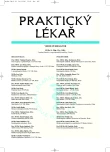Analysis of the lifestyle of seniors living at home focused on dietary habits
Authors:
E. Kudlová; A. Slámová
Authors‘ workplace:
Přednosta: prof. MUDr. Vladimír Bencko, DrSc.
; Ústav hygieny a epidemiologie 1. LF UK v Praze
Published in:
Prakt. Lék. 2006; 86(8): 439-442
Category:
Reviews
Overview
Background:
Studies demonstrate that reducing lifestyle risk factors even in older age presents health advantages. The elderly population is heterogeneous and while some studies describe inadequate diet, others evaluate the diet of seniors living at home as reasonably good. The aim of the present study is to evaluate the dietary habits and lifestyle of self-sufficient seniors living at home.
Methods and results:
Using a questionnaire we recorded and subsequently evaluated the dietary habits and lifestyles of 103 randomly selected individuals, 39 males and 64 females, aged 65–91 years living in Prague (54) and in smaller cities (49). Selection criteria met by addressing the subjects through the normal public channels was living outside an institution and a certain level of self-sufficiency. A level of P < 0.05 was regarded as statistically significant when comparing groups of respondents. Fifty seven percent of respondents had BMI 25 or higher. The weekly frequency of fruit and vegetable consumption was 12.8, milk and dairy products 10.1, dark bread and pastries 6.2, meat 4.6 and white bread and pastries 4.6. The daily fluid intake of a third of respondents was lower than the recommended minimum of 2 litres. Forty (38.8 %) persons took vitamin and/or mineral supplements. Fifty seven respondents performed some physical activity at least 3 times a week. The dietary habits of women, of respondents convinced that they live healthily and of non-smokers (81 respondents) were better. Habits, lack of money, health problems and ignorance were perceived as obstacles to a healthier diet. With few exceptions, a diagnosed disease has been the motivation for past, mostly positive changes.
Conclusions:
The overweight prevalence in seniors is comparable to its prevalence in the general Czech population. The diet of seniors is not worse than that of population at large, and the lack of physical activity is an equally alarming issue as it is in the whole population. Finding that the incentive for change of diet was an illness and not its prevention suggests that it is necessary to seek suitable approaches how to motivate the population towards lifestyle change.
Key words:
dietary habits, nutrition, lifestyle, seniors.
Labels
General practitioner for children and adolescents General practitioner for adultsArticle was published in
General Practitioner

2006 Issue 8
Most read in this issue
- Contraception and surgery
- Anaerobic sepsis: Lemierre syndrome
- Stroke and myocardial infarction – parallels and paradoxes
- Tuberculosis at the present
